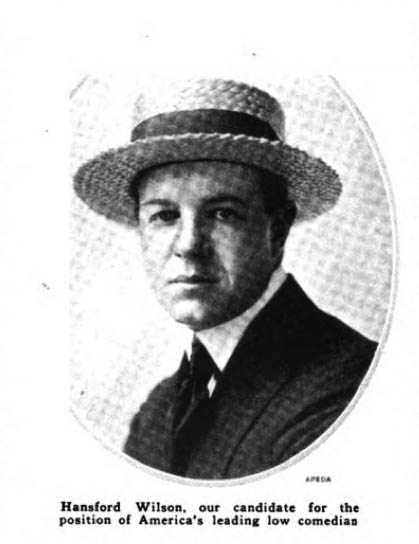Vanity Fair, April 1920
Hansford Wilson: Master of Comedy
An Appreciation by P. G. Wodehouse
I WAS talking to one of the biggest—at any rate, one of the fattest—English theatrical managers the other day, when he was on a visit to this country, and the conversation, oddly enough, happened to turn in the direction of the stage. “What strikes me very forcibly about the histrionic profession in the United States of America,” he said—you know how these managers talk—“is the fact that there are so few good low comedians. Light comedians, yes. But really clever low comedians, where are they? Name me some. Point me out a few. Enumerate me five or six.” I said: “Oh, ah!” or words to that effect, and so, as Ring Lardner would say, we kidded back and forth. And, dash it, his boat was half-way across the Atlantic before I had thought of what I ought to have said, to wit, “What about Hansford Wilson?” He would probably have replied, “Who is Hansford Wilson?” for he is fat of head as well as of body, and then I should have told him.
Hansford Wilson was the man who put the Stop and Look in Listen, Lester! If his comedy and acrobatic dancing were not the whole show, they were at least four-fifths of it. How well I remember the first time I saw him in that piece. It seems only last year. As far as I can recollect, he started a dancing step nor’-nor’-east and in the middle of it suddenly gave his spine a dexterous twist, wrapped a leg or two round his neck, spun a bit in mid-air, and before you could realize what had happened was headed sou’-sou’-west.

I am a plain, rough man, but I nearly broke down. I had been brought up in the Princess school of musical comedy, with its Macready pauses, its gentlemanly restraint and its stage so littered with priceless furniture that, if anyone wanted to dance they had to do it on top of the boule cabinet or the Louis Quatorze what-not; and I felt like some watcher of the skies when a new planet swims, if you follow me, into his ken, or—putting it another way—like stout Cortez (I know it was Balboa, really) when with eagle eyes he stared at the Pacific, and all his men looked at each other with a wild surmise, silent upon a peak in Darien. In other words, I could express it by saying I thought it pretty hot stuff.
Mr. Wilson as Pantomimist
I SAID to myself: “This, of course, is all this man does. It would be absurd to expect any more from him.” But no. In the intervals of dislocating his vertebræ, he played a long comedy part with an unction that was irresistible. He had one scene where he was alone on the stage for five minutes holding the audience all the while by clever business and sheer magnetism without saying a word.
All this was in Listen, Lester! In The Night Boat, at the Liberty, he has not quite the same amount of scope, but his Steward is the best of the many good things in that production. There is a briskness, a sense of character, and, above all, sincerity in everything Hansford Wilson does. He has a sheepish smile that is particularly engaging. He seems to be shrinking from the public gaze, and almost distressed that a lot of strangers should have happened to see him in the act of turning a somersault.
It is difficult to predict how far Hansford Wilson will go in his profession. One of these nights, probably, he will come unstuck or break in half or something, or be unable to disentangle his right ear from his left anklebone, for his motto, like that of a lesser member of the Wilson family, is May-I-Knot. If this misfortune does not happen I should say that round about the Fall of 1921 he will be definitely established as America’s leading low comedian. Or, make it the Spring of 1921.
 Madame Eulalie’s Rare Plums
Madame Eulalie’s Rare Plums